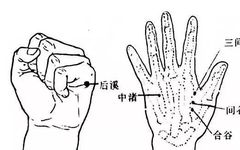Three Hand Acupuncture Points and Three Foot Acupuncture Points
1. The Three Hand Acupuncture Points are: Houshu (后溪), Zhongzhu (中渚), and Jiangu (间谷).
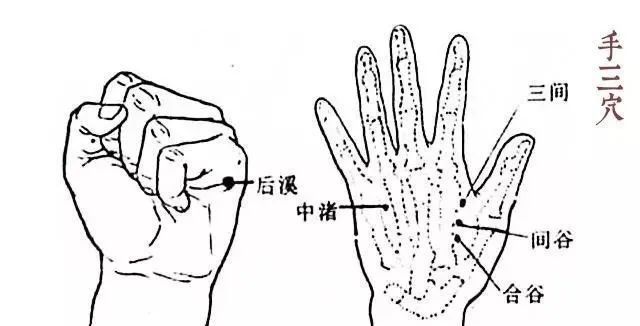
1. Jiangu Point (间谷穴)

This is a newly discovered acupuncture point in clinical practice, located at the midpoint of the line connecting the acupuncture points Sanjian (三间) and Hegu (合谷) on the Hand Yangming Large Intestine Meridian. The indications for Sanjian and Hegu are also applicable here.
It is particularly effective for pain and numbness in the neck, shoulder, elbow, arm, and fingers. It also treats headaches, toothaches, and lumbar pain.
The main treatment scope of Sanjian and Hegu according to “Acupuncture Essentials” is as follows:
Sanjian (三间): Treats throat obstruction, sensation of a lump in the throat, lower tooth decay pain, excessive sleepiness, fullness in the chest and abdomen, intestinal rumbling and diarrhea, cold and heat syndromes, dry lips and mouth, asthma, acute eye pain, tongue protrusion, stiff neck, excessive salivation, difficulty in eating, cold and heat syndromes, body cold with water retention, and 17 other conditions.
Hegu (合谷): Treats severe thirst due to cold damage, floating pulse, fever with chills, headache with stiff neck and no sweating, cold and heat syndromes, persistent nosebleeds, heat disease with no sweating, unclear vision, blood stasis, headache, lower tooth decay, deafness, throat obstruction, facial swelling, inability to close lips, inability to speak, locked jaw, hemiplegia, wind rash, and 22 other conditions.
The reason Jiangu can treat the above conditions is that it is located at the midpoint of the line connecting the two points, making it significantly more sensitive than either point.
By pressing this point with a fingernail or a small stick like a matchstick or a ballpoint pen, one will feel a sour and swollen sensation. Pressing Hegu will yield a lesser sensation, and pressing Sanjian will yield an even lesser sensation. The higher sensitivity of this point allows for quicker qi reception and faster therapeutic effects.
2. Zhongzhu Point (中渚)
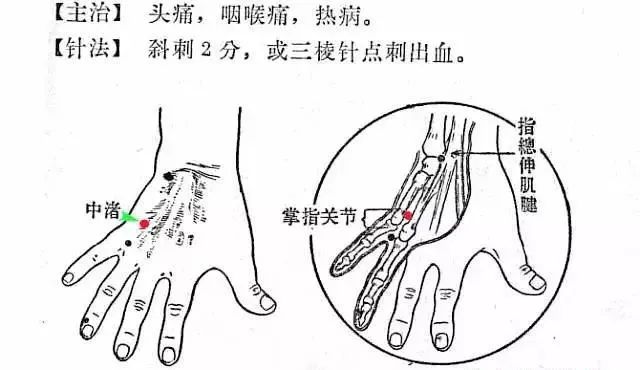
Located on the Hand Shaoyang Sanjiao Meridian, in the depression between the fourth and fifth metacarpophalangeal joints on the back of the hand.
Its indications, according to “Acupuncture Essentials,” include: “heat disease with no sweating, dizziness and headache, deafness, eye membrane formation, chronic malaria, throat swelling, elbow and arm pain, inability to flex or extend fingers,” etc.;
According to “Medical Classics,” it states: “numbness in the limbs, tremors, spasms, elbow and shoulder swelling and pain, abscesses on the back of the hand.”
3. Houshu Point (后溪)
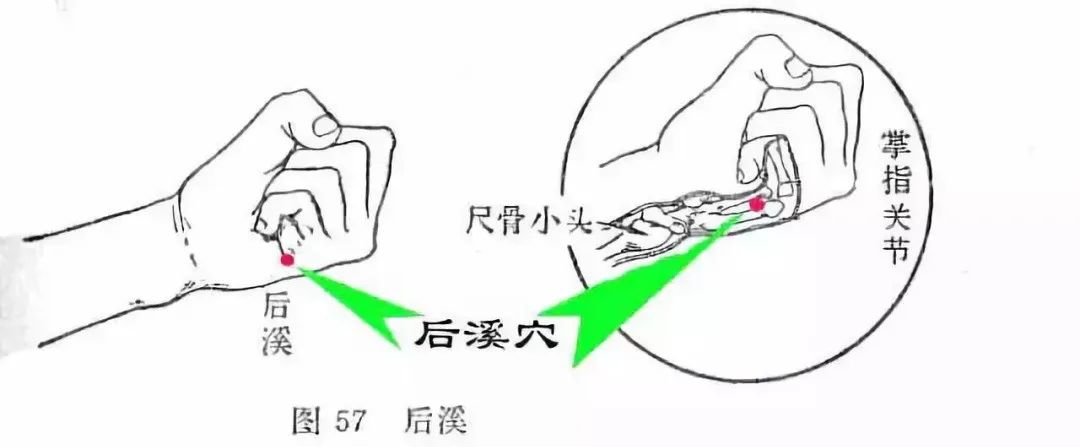
Located on the Hand Taiyang Small Intestine Meridian, behind the fifth metacarpal bone on the ulnar side, in the depression on the outer side of the little finger.
Its indications, according to “Acupuncture Essentials,” include: “malaria with cold and heat, red eyes with membrane formation, nosebleeds, deafness, chest fullness, inability to turn the head due to stiffness, epilepsy, elbow and arm rigidity, and skin diseases.”
According to “Medical Classics,” it states: “spasms and tremors in the hands and feet, sudden fainting due to stroke, inability to speak, epilepsy with loss of consciousness, convulsions, headaches, and sudden onset of red eyes, constant tearing, leg and back pain, stiffness in the neck, cold and flu with no sweating, inability to urinate, swelling and pain in the teeth and gums, numbness in the hands and feet, wind exposure, and night sweats.”
All three acupuncture points are located on the dorsal side of the hand and are along the pathways of the Hand Yang Meridians. They can be used individually to treat their respective main symptoms, and when combined, they have a synergistic effect. They can be used together, in pairs, or in conjunction with one or two points from the Three Foot Acupuncture Points for effective treatment of pain and numbness in the neck, shoulder, arm, elbow, fingers, back, spine, waist, hips, legs, feet, and toes.
In treating pain and swelling in the above areas, or headaches, toothaches, migraines, and rib pain (intercostal neuralgia, gallbladder or liver pain), the “Three Hand Acupuncture Points and Three Foot Acupuncture Points” are often effective enough to achieve a cure upon needle removal.
The method of locating these three acupuncture points is based on a fist being slightly relaxed.
2. The Three Foot Acupuncture Points are: Taichong (太冲), Neiting (内庭), and Zulinqi (足临泣).
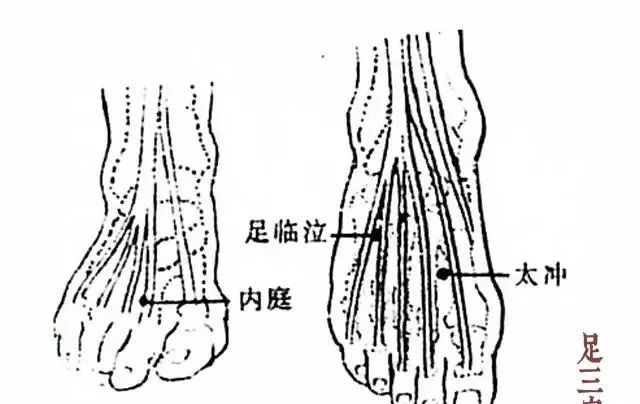
1. Zulinqi Point (足临泣)
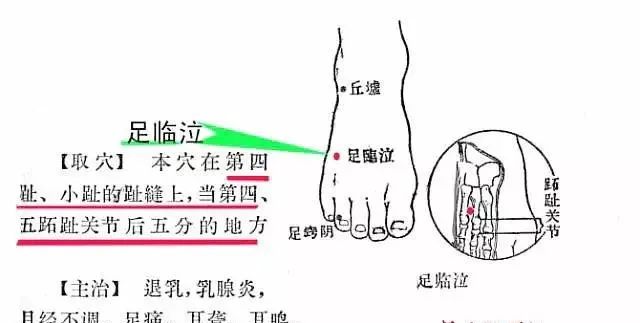
Located on the Foot Shaoyang Gallbladder Meridian, in the depression at the junction of the fourth and fifth metatarsal bones.
Its indications, according to “Acupuncture Essentials,” include: “fullness in the chest, abscesses in the axilla, excessive salivation, swelling in the Tianyou area, soreness, dizziness, occipital pain, chills, heart pain, and various pains in the limbs, inability to walk, daily malaria, and menstrual disorders in women.”
According to “Medical Classics,” it states: “difficult movements of the hands and feet due to stroke, numbness and pain, headache, toothache, throat swelling, and other symptoms can be treated effectively with this point.”
2. Neiting Point (内庭)
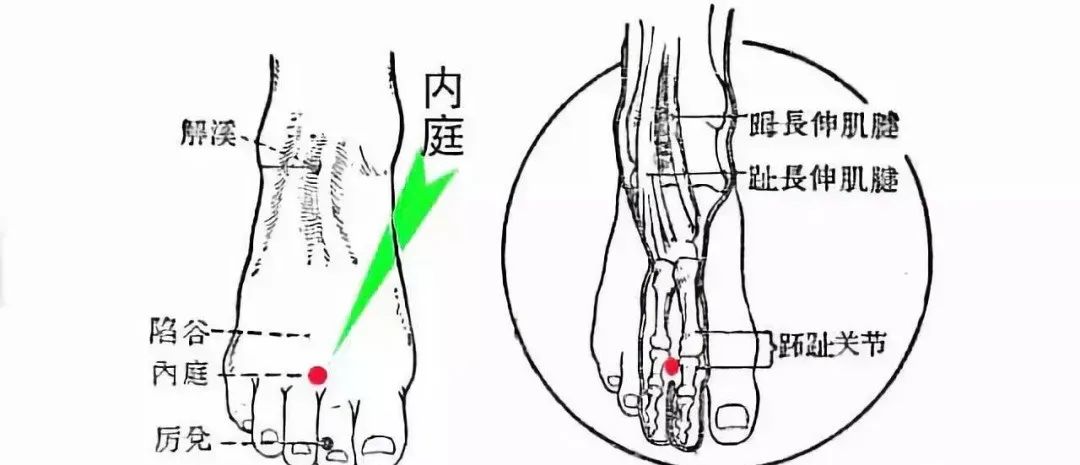
Located on the Foot Yangming Stomach Meridian, in the depression between the second and third metatarsophalangeal joints, on the outer side of the second toe. Its indications, according to “Acupuncture Essentials,” include: “cold limbs, abdominal distension, frequent yawning, aversion to human voices, chills, throat pain, dry mouth, tooth decay, loss of appetite, skin pain, persistent nosebleeds, cold limbs with no sweating, and dysentery.”
There is no mention of treating neck, shoulder, waist, or leg pain in the literature. However, in clinical practice, single needling of Neiting has shown particularly remarkable effects in treating pain and numbness in the thighs and calves (especially the anterior side), swelling and pain in the foot, and pain and numbness in the toes.
3. Taichong Point (太冲)
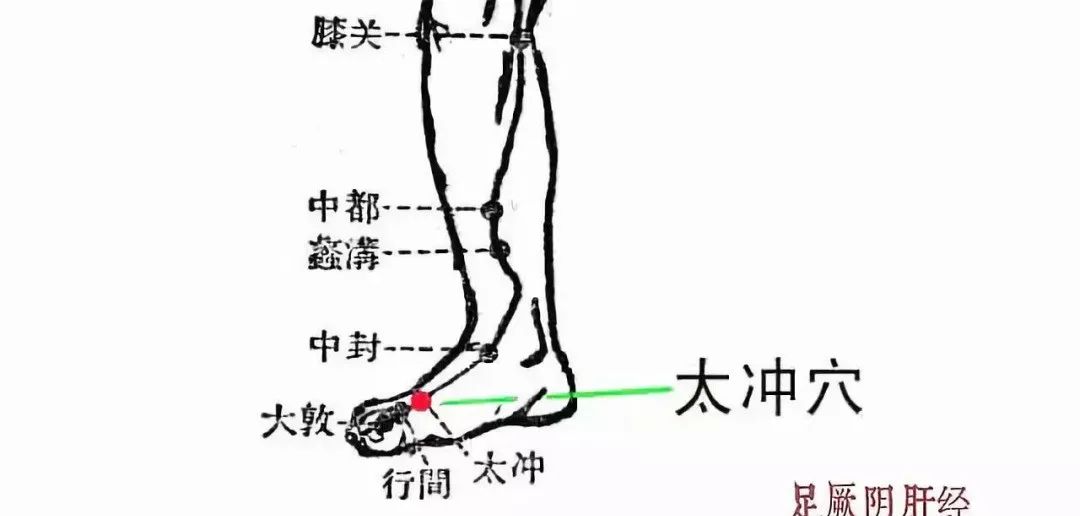
Located on the Foot Jueyin Liver Meridian, in the space between the first and second metatarsal bones, 1.5 inches behind the base of the big toe, where a pulse can be felt with light pressure.
Its indications, according to “Acupuncture Essentials,” include: “heart pain with a wiry pulse, yellowing of the skin, epidemics, shoulder swelling and pain, weakness and edema, lumbar pain radiating to the lower abdomen, testicular retraction, diarrhea, urinary incontinence, genital pain, pale complexion, fullness in the chest and ribs, cold feet, and various other conditions related to the point.”
Taichong is effective for pain and numbness in the inner thighs and calves, swelling and spasms in the feet, and sudden lumbar pain.
Among the six acupuncture points of the Three Hand and Three Foot Acupuncture Points, only Neiting does not have direct references to neck, shoulder, waist, or leg pain, while the other five points have prominent descriptions.
Based on experience, the indications for Neiting are not limited to those mentioned above; it has shown particularly remarkable effects on pain, swelling, stiffness, and numbness in the anterior side of the thighs, feet, toes, and both inner and outer ankles, yielding better results than those listed in ancient medical texts.
3. The Three Shoulder Acupuncture Points are: Jianyu (肩髃), Jianliao (肩髎), and Qiquan (奇穴肩前).
The Three Shoulder Acupuncture Points are named after the external extraordinary points. This point consists of the Jianyu point from the Large Intestine Meridian and the extraordinary points Jianqian (肩前) and Jianhou (肩后).
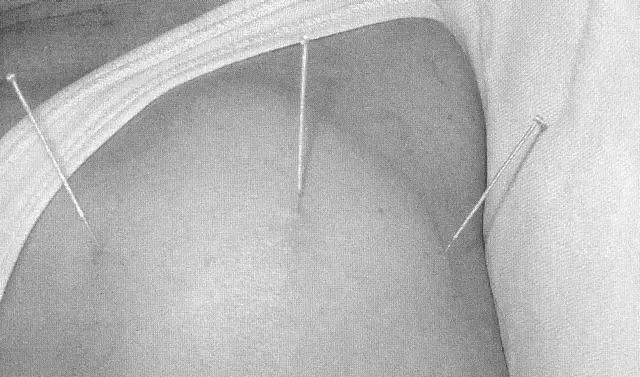
The indications for each of the Three Shoulder Acupuncture Points are as follows:
1. Jianyu Point (肩髃): This is the meeting point of the Hand Yangming Meridian and the Yang Qiao Vessel. When the shoulder is raised, two depressions appear; the front depression is the location of this point. According to “The Classic of Acupuncture and Moxibustion”: “Located between the two bones at the shoulder end”; “Essential Prescriptions of the Golden Cabinet – Various Winds”: “In the center of the two shoulder heads”; “Acupuncture Point Location Compilation”: “Between the two ends of the shoulder bones, at the midpoint when the arm is raised to shoulder level (slightly forward), directly opposite the elbow joint, the arm should be relaxed or the hand placed on the waist, and the needle should be inserted slowly.”
Effect: Dispels wind and dampness from the meridians, clears Yangming heat, unblocks the joints, and expels pathogens and relieves heat.
Indications: Ancient descriptions include: heat in the shoulder, cold in the shoulder, finger numbness and arm pain, hemiplegia, heat rash, arm spasms, weakness in the arms, and joint pain. Recent reports include: stroke hemiplegia, hypertension, shoulder periarthritis, and urticaria.
2. Jianliao Point (肩髎): This is the 14th point of the Hand Shaoyang Sanjiao Meridian. Located in the upper part of the posterior deltoid muscle, below the shoulder peak, in the depression when the arm is raised laterally. Indications: Ancient descriptions include: inability to lift the shoulder, arm pain, and stroke hemiplegia. Recent reports include: shoulder periarthritis (frozen shoulder).
3. Qiquan Point (肩前): This is an extraordinary point located on the shoulder. When sitting upright with arms hanging down, it is at the midpoint of the line connecting the top of the front axillary fold and Jianyu point. The diseases treated by Qiquan include: shoulder and arm pain, and inability to lift the arm.
The indications for the Three Hand and Three Foot Acupuncture Points:
The causes of neck, shoulder, waist, and leg pain are quite complex, and in some cases, the cause cannot be identified, even with advanced imaging techniques like CT and MRI.
Not being able to find a cause does not mean there is no disease. The Three Hand and Three Foot Acupuncture Points have shown remarkable efficacy for over 90% of neck, shoulder, waist, and leg pain, particularly for trigeminal neuralgia, intercostal neuralgia, headaches, and toothaches.
However, a small portion of neck, shoulder, waist, and leg pain may not respond well to treatment with the Three Hand and Three Foot Acupuncture Points. The term “effective” here refers to cure or significant improvement; lack of effectiveness does not mean no therapeutic effect.
For example, taking painkillers only alleviates pain temporarily; once the effect wears off, the pain returns. One cannot say painkillers are ineffective; they are effective in relieving pain but do not eliminate the underlying cause. The Three Hand and Three Foot Acupuncture Points are ideal for pain relief in neck, shoulder, and waist pain, and this should also be considered a therapeutic effect.
The Mechanism of Action of the Three Hand and Three Foot Acupuncture Points in Treating Neck, Shoulder, and Waist Pain:
The action of the Three Hand and Three Foot Acupuncture Points is understood through the meridian pathways of the six acupuncture points.
The Three Hand Acupuncture Points are located on the three Yang meridians of the hand, while only Taichong is on the Foot Jueyin Meridian; the other two points are on the Yang meridians of the foot.
The pathways of the Hand Yang meridians run from the fingers → back of the hand → forearm → upper arm → shoulder → neck → head and face, connecting with the Foot Yang meridians, which run from the head to the foot, with Yangming in the front, Shaoyang on the side, and Taiyang at the back.
The Foot Yin meridians run from the foot to the abdomen, while the Hand Yin meridians run from the chest to the hand, creating a continuous cycle that connects the organs and limbs, facilitating communication between the upper and lower body, and regulating the pathways of various tissues and organs, making the body an organic whole.
There are approximately 218 acupuncture points on the Hand and Foot Yang meridians that can be used to treat neck, shoulder, and waist pain, with about 130 points applicable; there are 91 points on the Hand and Foot Yin meridians, with 46 points applicable for treating neck, shoulder, waist, and leg pain; and 28 points on the Governing Vessel, with 20 points applicable for the above conditions. The Ren Meridian has no points for treating these conditions.
In total, there are about 196 acupuncture points that can treat pain and numbness in the neck, shoulder, waist, and legs. If we include extraordinary points, Tianying points, ear points, and others, the number is truly incalculable. With so many acupuncture points, clinical application can be quite complex.
In clinical practice, whenever the above symptoms are observed, regardless of the cause, treatment is first administered using the Three Hand and Three Foot Acupuncture Points, generally without additional points. Of course, the indications for these six points may not be as extensive as the 196 points; however, based on experience, the vast majority of conditions within this range can achieve significant results.
Characteristics of the Three Hand and Three Foot Acupuncture Points:
1. Few acupuncture points are needed. The maximum number of points for the Three Hand and Three Foot Acupuncture Points is only six. However, in general, only 1 to 3 points are needed, and it is very rare to use both the Three Hand and Three Foot Acupuncture Points together.
2. Quick needle insertion. The speed of needle insertion is as fast as lightning, generally not exceeding 1 second.
3. Quick technique. The needle enters the point like lightning, and the technique should be as swift as a gale. From insertion to completion of the technique takes only a few seconds.
4. Quick qi reception. The special effect of the quick technique is that qi is received quickly; as soon as the technique is applied, qi is immediately felt, with a sensation of heaviness and swelling at the point.
5. Quick results. The effect is felt immediately; in the best cases, within a few seconds, and in slower cases, within 10 seconds, pain relief is often felt.
6. Short needle retention time. The duration of needle retention is related to the presence or absence of therapeutic effects and their quality.
If the effect is significant, the needle can be removed immediately; if the sensation is weak and the effect is not significant, the retention time can be slightly longer. In practice, the duration from insertion to removal of the needle is generally around 1 minute, with 2 to 3 minutes being rare.
Specific Techniques for the Three Hand and Three Foot Acupuncture Points:
1. Preparation before needling: Alleviate the patient’s anxiety; have the patient relax their fist and locate the points; disinfect the points as per standard procedure.
2. Insertion angle: The physician holds the needle with the right thumb and index finger, exposing 1 to 1.5 cm of the needle tip. First, apply slight pressure with the left thumb on the point, then quickly insert the needle with the right hand. Houshu and Jiangu are inserted vertically, while Zhongzhu and the Three Foot Acupuncture Points are inserted at a 30-degree angle.
3. Needle manipulation for qi reception: After the needle reaches a certain depth, the physician quickly lifts the needle to the subcutaneous layer with the right hand’s thumb, index, and middle fingers, and then swiftly completes the needle manipulation for the other two points, resulting in qi sensation.
4. Activity with the needle: After qi reception, the physician releases the grip on the needle handle, allowing the patient to move. For neck pain, the patient should shake their head and tilt it back; for shoulder and elbow pain, various arm movements should be performed; for waist pain, bending and lateral bending should be done; for leg pain, various leg movements should be performed, etc. Generally, after qi reception, pain is immediately reduced or even disappears. When the patient reaches a painful position, they should stop moving, and the physician will manipulate the needle by lifting or rotating it, asking the patient if the pain has lessened or disappeared. When a painful position disappears, the patient is encouraged to move to find the painful position again.
5. Effectiveness and needle removal: From qi reception to the patient finding the painful position, the time from effectiveness to needle removal is generally 1 to 2 minutes. If one needle is effective in relieving pain, it can be removed; if the effect is not significant, another point can be selected.
Principles for Selecting Acupuncture Points for the Three Hand and Three Foot Acupuncture Points:
Generally speaking: for headaches, neck pain, hand tremors, stiffness in the arms, back pain, lumbar pain, tailbone pain, acute lumbar pain, sprains, trigeminal neuralgia, and toothaches, use Houshu (which connects to the Governing Vessel). For shoulder pain, elbow pain, and numbness in the arms, use Jiangu. For numbness and pain in the arms, finger tremors, weakness in grip, and elbow pain, use Zhongzhu. For shoulder periarthritis and pain in the front and back of the shoulder, all three points can be used together, or Jiangu can be the main point with Zhongzhu or Houshu as adjuncts. In any case, the selection should prioritize points that yield good results while minimizing the number of points used.
The Three Hand Acupuncture Points are primarily used, with the Three Foot Acupuncture Points as adjuncts. However, for lumbar and leg pain, the Three Foot Acupuncture Points are essential, with Zulinqi as the main point.
In practice, for pain above the chest, the Three Hand Acupuncture Points are the main points, while the Three Foot Acupuncture Points are adjuncts. For pain below the chest, the Three Foot Acupuncture Points are the main points, while the Three Hand Acupuncture Points are adjuncts.
The Indications for the Three Hand and Three Foot Acupuncture Points:
1. Cervical Spondylosis: Use bilateral Houshu, first needling the left side, inserting quickly in a “↑” shape (vertical insertion), and the patient will immediately feel a flow of qi from the left arm through the neck to the upper back; then needle the right Houshu, allowing the neck to rotate left and right, flex and extend, still slightly stiff and painful, but significantly reduced compared to before needling; then have the patient move both arms with the needle in place, resulting in a sharp reduction in shoulder pain. For nerve root type cervical spondylosis, needle Houshu and Zhongzhu, and after qi reception, pain is immediately relieved, then have the patient shake their head and move the affected shoulder and arm, resulting in over 50% pain reduction. Needle once daily, generally 3 to 10 sessions for recovery.
2. Shoulder Pain: There are various causes of shoulder pain: obstruction of meridians due to wind, cold, and dampness; acute and chronic inflammation of shoulder soft tissues; overuse; trauma; and sprains. All these can be treated effectively with the Three Hand Acupuncture Points, often resulting in significant improvement. If the pain occurs only during movement, without adhesions, or if there are mild adhesions, it often resolves after one or two sessions. If there is significant tenderness upon palpation of the shoulder and shoulder peak, or tenderness in the subacromial bursa, or tenderness in the inner and lower sides of the scapula, and limited external rotation and abduction of the shoulder joint, needle Jiangu and Zhongzhu, and after qi reception, have the patient move to find the pain point, resulting in immediate pain relief or significant reduction. Needle every other day, generally 3 to 10 sessions for recovery.
3. Elbow Pain: Needle Zhongzhu and Jiangu, occasionally adding Quchi (曲池) (vertical insertion). For lateral epicondylitis, needle Jiangu, inserting 2 inches deep to receive qi, then lift the needle to the subcutaneous layer, and at a 15-degree angle, needle towards Hegu on the lateral side, lifting and rotating three times, then have the patient move. Needle every three days.
4. Finger Numbness: Needle Jiangu and Zhongzhu, occasionally adding Houshu, needle every three days. Alternatively, needle the Three Hand Acupuncture Points in conjunction with Waiguan (外关), needle every other day; when needling Waiguan, first needle through Neiguan (内关) vertically, then lift the needle to the subcutaneous layer and needle at a 30-degree angle towards Jiangu, and then needle towards the wrist joint, using moxibustion on the points needled for 15 to 20 minutes each, twice daily. The Three Hand Acupuncture Points are commonly used in conjunction with Waiguan for treating neck, shoulder, waist, and leg pain.
5. Lumbar and Leg Pain: Needle Houshu and Zhongzhu, occasionally needle Zulinqi and Neiting, and have the patient move.
6. Coccyx Pain: Needle bilateral Houshu, needle every other day.
7. Lumbar Osteophytes: Lumbar osteophytes, lumbar disc herniation, and associated sciatica can all be treated by needling Zhongzhu, occasionally needling bilateral Taichong, and after qi reception, the needle can be removed. The Three Hand and Three Foot Acupuncture Points are effective for treating cervical, lumbar, and heel osteophytes, particularly in relieving pain and numbness, but about one-third of patients may require additional therapies, such as external treatment methods and internal herbal medicine, after needle therapy.
8. Sacroiliac and Hip Joint Pain: Needle bilateral Neiting, penetrating through Yongquan (涌泉) to the anterior edge of the heel, inserting quickly, forming an “↑” shape at the foot. After qi reception, have the patient move their legs. Then, combine with external treatment methods and internal herbal medicine, generally recovering in 1 to 3 months.
9. Hand Tremors: Needle Houshu, in conjunction with Zhongzhu, alternating needling after symptoms improve. Needle daily.
10. Rib Pain: Needle Zhongzhu, allowing the patient to take a deep breath and cough, which enhances the effect. This can be combined with treatment for neck, shoulder, waist, and leg pain, and trigeminal neuralgia. If ineffective, needle the painful side’s Zhigou (支沟) point after removing the needle.
11. Inner Thigh Pain and Stiffness: Needle the affected side’s Taichong, after qi reception, lift the needle to the subcutaneous layer, directing the needle tip inward, and needle towards the posterior edge of the first metatarsal, then have the patient move to find the painful position.
12. Foot Pain and Swelling: Needle from Neiting through Yongquan to the anterior edge of the heel, lifting the needle to the subcutaneous layer, then inserting laterally in an “↑” shape to remove the needle. Needle daily, with several sessions for recovery. The Yongquan point is also effective for this condition.
13. Trigeminal Neuralgia: Needle the affected side’s Houshu, inserting quickly, and after qi reception, have the patient perform chewing motions, often resulting in immediate pain relief. If pain does not stop immediately, needle the same side’s Yifeng (翳风) point, which usually has an immediate effect.
The needling technique for Yifeng: The first needle is inserted directly to receive qi, then lifted to the subcutaneous layer and angled upward; the second needle is inserted directly; the third needle is inserted directly to receive qi, then lifted to the subcutaneous layer and angled downward.
14. Persistent Headaches or Dizziness: Needle Houshu. First needle one side; for right-sided pain, needle right Houshu; for left-sided pain, needle left Houshu; for frontal, central, or occipital pain, needle bilaterally, using a slow and gentle lifting and inserting technique. If the effect is still not significant, needle both Houshu points first, then needle Yamen (哑门); if there are concerns about the safety of Yamen, needle Dazhui (大椎) instead. This combination often yields immediate results.
Experience with Adjunct Points:
1. Headaches: Jiangu, Houshu, (Zhongzhu, Taichong)
2. Pain in the five sense organs: Jiangu, Zhongzhu, (Houshu, Taichong, Neiting)
3. Neck, shoulder, arm, and hand pain: Zhongzhu, Houshu, (Jiangu, Zulinqi)
4. Chest, back, waist, and leg pain: Taichong, Neiting, Zulinqi, (Houshu)
Note: (Points in parentheses are adjunct points)
The Combination of the Three Hand and Three Foot Acupuncture Points with Zusanli (足三里):
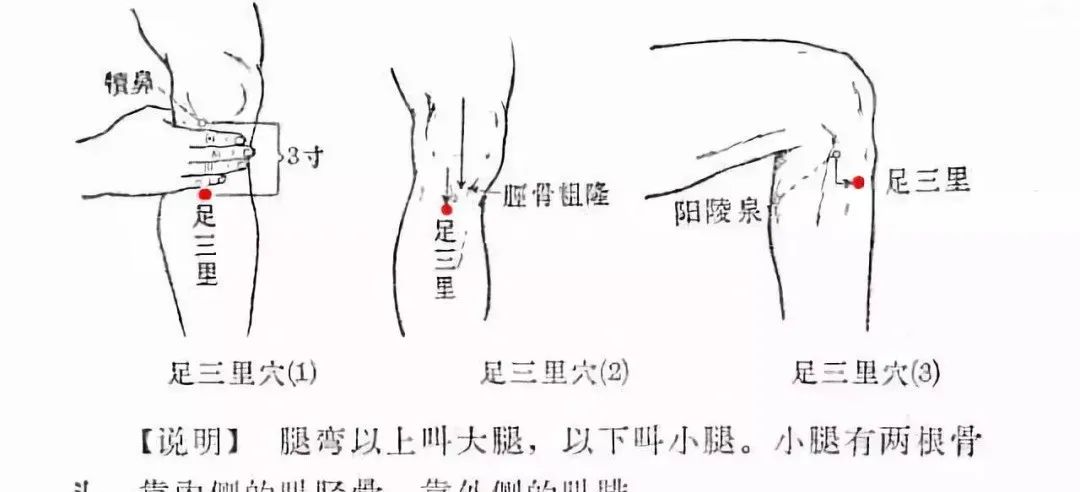
Using Zusanli in conjunction with the “Three Hand and Three Foot Acupuncture Points” for treating neck, shoulder, waist, and leg pain, as well as trigeminal neuralgia, persistent headaches, toothaches, and other difficult pain conditions, yields remarkably rapid and definitive results, often resulting in immediate relief upon needle insertion and removal.
Zusanli (三里 is a vital point for strengthening; if you want to be safe, the three feet should always be connected.)
The Combination of the Three Hand and Three Foot Acupuncture Points with the Three Shoulder Acupuncture Points:
The Three Shoulder Acupuncture Points combined with Quchi, Waiguan, Hegu, Houshu, and Lieque can invigorate blood circulation and unblock meridians, treating upper limb paralysis;
The Three Shoulder Acupuncture Points combined with Tianjing, Tianding, Houshu, and Neiguan can tonify qi, invigorate blood circulation, dispel dampness, and unblock meridians, treating atrophy syndrome;
The Three Shoulder Acupuncture Points combined with Tianzong, Jianjing, Tianding, Binao, Quchi, and Waiguan can dispel wind, eliminate dampness, invigorate blood circulation, and treat frozen shoulder.
Traditional acupuncture therapy generally begins with identifying the main treatment points based on syndrome differentiation, followed by adjunct points, and then determining the needling technique. For treating shoulder periarthritis, some acupuncturists may select Jianzheng, Jianyu, Jianjing, and then add Hegu, Waiguan, and Zusanli; others may choose Jianzheng, Binao, and add Hegu, Waiguan, and Quchi; after needling, patients are generally instructed to sit still (which I refer to as static needling), with needling performed every three to five minutes, or combined with moxibustion or electrical stimulation, for 20 to 30 minutes before removing the needles. However, when using the Three Hand Acupuncture Points to treat shoulder pain, if the pain is in the front of the shoulder, only Jiangu is needled; if the pain is in the back of the shoulder, only Zhongzhu or Houshu is needled; if the entire shoulder is painful, needle Jiangu and Zhongzhu, or combine with Houshu, and after needling, the patient should be encouraged to move to find the painful angles and positions, without leaving the needles in for more than 2 minutes.
After observing thousands of cases, it has been found that the efficacy of static needling (i.e., having the patient sit still during needling) for treating neck, shoulder, waist, and leg pain is far inferior to that of dynamic needling (having the patient move after needling). This is because if there is no flow, there is pain; the flow of static needling is slow and the intensity is too weak. Adding movement after needling enhances and amplifies the flow of qi in the meridians, resulting in rapid and stable therapeutic effects. Only when needling in the fingers, palms, toes, or in the ear, nose, face, or head can the limbs and joints move. Any needling in areas with significant muscle tension will affect the mobility of the limbs and joints, as movement will cause bending during needling.
The indications for Neiting are not limited to those mentioned above; it has shown particularly remarkable effects on pain, swelling, stiffness, and numbness in the anterior side of the thighs, feet, toes, and both inner and outer ankles, yielding better results than those listed in ancient medical texts. In clinical practice, it has been found that the indications for Neiting are not documented in acupuncture textbooks; however, the “Concise Dictionary of Traditional Chinese Medicine” (March 1988, People’s Health Edition) mentions under the Foot Yangming Stomach Meridian that “… swelling in the neck… pain along the meridian” is noted, although not explicitly stated, it is referenced. I have written down my superficial experiences regarding Neiting for colleagues to verify, which may provide some reference value for using the Three Hand and Three Foot Acupuncture Points to treat neck, shoulder, waist, and leg pain and other difficult pain conditions.
⊙ Copyright Statement: Some articles and images in this public account are sourced from the internet. If there is any infringement, please contact us for deletion.
⊙ Submission Email: [email protected] (We welcome your original submissions)
⊙ Editor: Lianxi (WeChat ID: 13853687565)
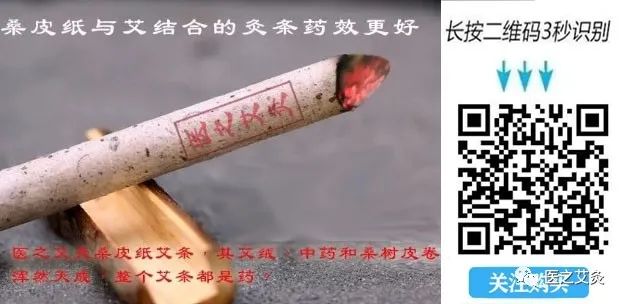
If you have any questions, feel free to leave a message for Xiao Jiu. Xiao Jiu will update the public account based on feedback and questions from everyone. If you like it, remember to follow Xiao Jiu!
In the lower left corner of our public account homepage, there is a “Point Finder” tool, where you can find all the meridian points and learn a lot of different point knowledge.

